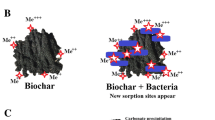Abstract
Microbiological evaluation of sandy grassland soils from two different stages of secondary succession on abandoned fields (4 and 8 years old fallow) was carried out as a part of research focused on restoration of semi-natural vegetation communities inKiskunság National Park in Hungary. There was an apparent total N and organic C enrichment, stimulation of microbial growth and microbial community structure change on fields abandoned by agricultural practice (small family farm) in comparison with native undisturbed grassland. A successional trend of the microbial community was found after 4 and 8 years of fallow-lying soil. It consisted in a shift of r-survival strategy to more efficient C economy, in a decrease of specific respiration and metabolic activity, forced accumulation of storage bacterial compounds and increased fungal distribution. The composition of microbial phospholipid fatty acids mixture of soils abandoned at various times was significantly different.
Similar content being viewed by others
References
Amato M., Ladd J.N.: Assay for microbial biomass based on ninhydrin reactive nitrogen in extracts of fumigated soil.Soil Biol. Biochem. 20, 107–114 (1988).
Anderson J.M.: Spatio-temporal effects on invertebrates on soil processes.Biol. Fertil. Soils 7, 216–227 (1988).
Atlas R.M., Bartha R.:Microbial Ecology. Fundamentals and Applications. Benjamin/Cummings, New York 1993.
Bardgett R.M., Hobbs P.J., Frostegård Å.: Changes in the structure of soil microbial communities following reductions in the density of management of an upland.Biol. Fertil. Soils 22, 261–264 (1996).
Bremner J.M.: Inorganic forms of nitrogen, pp. 1179–1237 in C.A. Black (Ed.):Methods of Soil Analysis, Part 2—Agronomy 9. American Society of Agronomy, Madison (WI, USA) 1965.
Dawes E.A., Senior P.J.: The role and regulation of energy reserve polymers in micro-organisms.Adv. Microb. Physiol. 10, 135–266 (1973).
Elhottová D., Tříska J., Šantrůčková H., Květoň J., Šantrůček J., Šimková M.: Rhizosphere microflora of winter wheat plants cultivated under elevated CO2.Plant & Soil 197, 251–259 (1997).
Elhottová D., Tříska J., Petersen S.O., Šantrůčková H.: Analysis of poly-β-hydroxybutyrate in environmental samples by GC-MS/MS.Fresenius J. Anal. Chem. 367, 157–164 (2000).
Erwin J.A.: Fatty acids in eukaryotic microorganisms, pp. 41–143 in J.A. Erwin (Ed.):Lipids and Biomembranes of Eukaryotic Microorganisms. Academic Press, New York 1973.
Federle T.W.: Microbial distribution in soil—new techniques, pp. 493–498 in F. Megusar, M. Gantar (Eds):Perspectives in Microbial Ecology. Slovene Society for Microbiology, Ljubljana (Slovenia) 1986.
Frostegård Å., Tunlid A., Bååth E.: Phospholipid fatty acids composition, biomass, and activity of microbial communities from two soil types experimentally exposed to different heavy metals.Appl. Environ. Microbiol. 59, 3605–3617 (1993).
Grayston S.J., Vaughan D., Jones D.: Rhizosphere carbon flow in trees, in comparison with annual plants: the importance of root exudation and its impact on microbial activity and nutrient availability.Appl. Soil Ecol. 5, 29–56 (1996).
Hansson M., Fogelfors H.: Management of permanent setaside on arable land in Sweden.J. Appl. Ecol. 35 758–771 (1998).
Hršelová H., Chvátalová I., Vosátka M., Klír J., Gryndler M.: Correlation of abundance of arbuscular mycorrhizal fungi, bacteria and saprophytic microfungi with soil carbon, nitrogen and phosphorus.Folia Microbiol. 44, 683–688 (1999).
Insam H., Domsch K.H.: Relationship between soil organic biomass on chronosequences of reclamation sites.Microb. Ecol. 15, 177–188 (1988).
Klein D.A., McLendon T., Paschke M.W., Redente E.F.: Saprophytic fungal-bacterial biomass variations in successional communities of a semiarid steppe ecosystem.Biol. Fertil. Soils 19, 253–256 (1995).
Klein D.A., McLendon T., Paschke M.W., Redente E.F.: Nitrogen availability and fungal-bacterial responses in successional semiarid steppe soils.Arid Soil Res. Rehabil. 10, 321–332 (1996).
Klein D.A., Paschke M.W., Redente E.F.: Assessment of fungal-bacterial development in successional semi-arid grassland by direct integration of chloroform-fumigation extraction (FE) and microscopically derived data.Soil Biol. Biochem. 30, 573–581 (1998).
Kowalchuk G.A., Stienstra A.W., Heilig G.H., Stephen J.R., Woldendorp J.W.: Changes in the community structure of ammonia-oxidizing bacteria during secondary succession of calcareous grasslands.Environ. Microbiol. 2, 99–110 (2000).
Kroppenstedt R.M.: Fatty acid and menaquinone analysis of actinomycetes and related organisms, pp. 173–199 in M. Goodefellow, D.E. Minnikin (Eds).Chemical Methods in Bacterial Systematics. Academic Press, London 1985.
Malý S., Korthals G.W., Van Dijk C., Van der Putten W.H., De Boer W.: Effect of vegetation manipulation of abandoned arable land soil microbial properties.Biol. Fertil. Soils 31, 121–127 (2000).
O’Leary W.M., Wilkinson S.G.: Gram-positive bacteria, pp. 117–201 in C. Ratlege, S.G. Wilkinson (Eds):Microbial Lipids, Vol. 1. Academic Press, London 1988.
Paschke M., McLendon T., Redente E.F.: Nitrogen availability and old-field succession in a shortgrass steppe.Ecosystems 3, 144–158 (2000).
Post W.M., Kwon K.C.: Soil carbon sequestration and land-use change: processes and potential.Global Change Biol. 6, 317–327 (2000).
Šantrůčková H.: Microbial biomass, activity and respiration in relation to secondary succession.Pedobiologia 36, 341–350 (1992).
Scheu S.: Changes in microbial nutrient status during secondary succession and its modification by earthworms.Oecologia 84, 351–358 (1990).
Schnürer J., Rosswall T.: Fluorescein diacetate hydrolysis as a measure of total microbial activity in soil and litter.Appl. Environ. Microbiol. 43, 1256–1261 (1982).
Semenov A. M., Hanzlíková A., Jandera A.: Quantitative estimation of poly-3-hydroxybutyric acid in some oligotrophic polyprosthecate bacteria.Folia Microbiol. 34, 267–270 (1989).
Szili-Kovács T., Halassy M., Török K.: Restoration of sandy grassland through the immobilisation of soil nitrogen—I. Laboratory incubation experiments.Agrokémia és Talajtan 49, 491–504 (2000).
Tilman D.: Nitrogen-limited growth in plants from different successional stage.Ecology 67, 555–563 (1986).
Török K., Szili-Kovács T., Halassy M., Tóth T., Hayek Z., Paschke M.W., Wardell L.J.: Immobilization of soil nitrogen as a possible method for the restoration of sandy grassland.Appl. Veget. Sci. 3, 7–14 (2000).
Vance E.D., Brookes P.C., Jenkinson D.S.: An extraction method for measuring soil microbial biomass-C.Soil Biol. Biochem. 19, 703–707 (1987).
Walkley A., Black I.A.: An examination of the Degtjareff method for measuring soil organic matter and proposed modification of the chromic acid titration method.Soil Sci. 37, 29–38 (1934).
Wardle D.A., Ghani A.: A critique of the microbial metabolic quotient (q CO 2) as a bioindicator of disturbance and ecosystem development.Soil Biol. Biochem. 27, 1601–1610 (1995).
Whang K., Hattori T.: Oligotrophic bacteria from rendzina forest soil.Antonie van Leeuwenhoek 54, 19–36 (1988).
Wilkinson S.G.: Gram-negative bacteria, pp. 299–488 in C. Ratlege, S.G. Wilkinson (Eds):Microbial Lipids, Vol. 1. Academic Press, London 1988.
Zak D.R., Grigal D.F., Gleeson D.F., Tilman D.: Carbon and nitrogen cycling during old-field succession: constraints of plant and microbial biomass.Biogeochemistry 11, 111–129 (1990).
Zelles L., Bai Q.Y., Beck T., Beese F.: Signature fatty acids in the phospholipids and lipopolysaccharide as indicators of microbial biomass and community structure in agricultural soils.Soil Biol. Biochem. 24, 317–323 (1992).
Zelles L., Bai Q.Y., Ma R.X., Rackwitz R., Winter K., Beese F.: Microbial biomass, metabolic activity and nutritional status determined from fatty acid patterns and poly-hydroxybutyrate in agriculturally-managed soils.Soil Biol. Biochem. 26, 439–446 (1994).
Author information
Authors and Affiliations
Corresponding author
Rights and permissions
About this article
Cite this article
Elhottová, D., Szili-Kovács, T. & Tříska, J. Soil microbial community of abandoned sand fields. Folia Microbiol 47, 435–440 (2002). https://doi.org/10.1007/BF02818704
Received:
Revised:
Published:
Issue Date:
DOI: https://doi.org/10.1007/BF02818704




